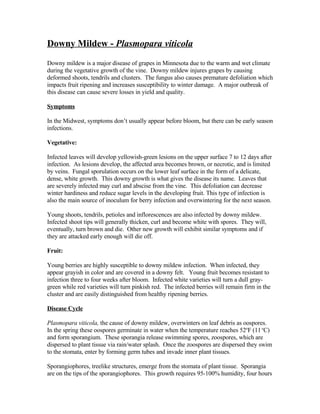
Downy Mildew
- 1. Downy Mildew - Plasmopara viticola Downy mildew is a major disease of grapes in Minnesota due to the warm and wet climate during the vegetative growth of the vine. Downy mildew injures grapes by causing deformed shoots, tendrils and clusters. The fungus also causes premature defoliation which impacts fruit ripening and increases susceptibility to winter damage. A major outbreak of this disease can cause severe losses in yield and quality. Symptoms In the Midwest, symptoms don’t usually appear before bloom, but there can be early season infections. Vegetative: Infected leaves will develop yellowish-green lesions on the upper surface 7 to 12 days after infection. As lesions develop, the affected area becomes brown, or necrotic, and is limited by veins. Fungal sporulation occurs on the lower leaf surface in the form of a delicate, dense, white growth. This downy growth is what gives the disease its name. Leaves that are severely infected may curl and abscise from the vine. This defoliation can decrease winter hardiness and reduce sugar levels in the developing fruit. This type of infection is also the main source of inoculum for berry infection and overwintering for the next season. Young shoots, tendrils, petioles and inflorescences are also infected by downy mildew. Infected shoot tips will generally thicken, curl and become white with spores. They will, eventually, turn brown and die. Other new growth will exhibit similar symptoms and if they are attacked early enough will die off. Fruit: Young berries are highly susceptible to downy mildew infection. When infected, they appear grayish in color and are covered in a downy felt. Young fruit becomes resistant to infection three to four weeks after bloom. Infected white varieties will turn a dull gray- green while red varieties will turn pinkish red. The infected berries will remain firm in the cluster and are easily distinguished from healthy ripening berries. Disease Cycle Plasmopara viticola, the cause of downy mildew, overwinters on leaf debris as oospores. In the spring these oospores germinate in water when the temperature reaches 52oF (11 oC) and form sporangium. These sporangia release swimming spores, zoospores, which are dispersed to plant tissue via rain/water splash. Once the zoospores are dispersed they swim to the stomata, enter by forming germ tubes and invade inner plant tissues. Sporangiophores, treelike structures, emerge from the stomata of plant tissue. Sporangia are on the tips of the sporangiophores. This growth requires 95-100% humidity, four hours
- 2. of darkness and a temperature of 64-72oF (18-22oC). The sporangia are then dispersed by wind or rain/water splash to the stomata of plant tissue. They will germinate in free water with a temperature of 72-77oF (22-25oC) and release zoospores. These zoospores cause secondary infections within two hours of wetting, with a temperature of 77oF (25oC), or within nine hours at a temperature of 43oF (6oC). Infected leaves will start exhibiting symptoms, yellowish lesions, seven to twelve days after infection. The secondary infection cycle is dependent on the frequency of suitable weather conditions. Control Strategies Proper site selection is the first step in controlling downy mildew. Choose a site where vines are exposed to sun all day through the growing period. Choosing resistant cultivars, such as Frontenac, Frontenac Gris, Marquette or Marechal Foch, is also important in reducing the impact of downy mildew. The most efficient way to control downy mildew is the use of good cultural practices. Utilize pruning and training systems to improve air circulation which promote rapid leaf drying. This will help reduce the wetting period the pathogen needs to infect the plant. Pruning will also help with full spray coverage and canopy penetration. Clear crop debris from the ground after leaf drop or incorporate it into the soil at the beginning of the season. This will greatly reduce the source of overwintering inoculum in the vineyard. Proper weed control and good soil drainage will reduce the relative humidity which increases the spread of the pathogen. Implementing a properly timed spray program is essential for managing downy mildew in the vineyard. Monitor susceptible cultivars, particularly vinifera cultivars, all season. Start monitoring other varieties just prior to bloom through fourteen days after bloom. Late season monitoring should be done when heavy dew or foggy weather is prevalent. Downy mildew can be controlled by proper timing and effective fungicides. For the most current spray recommendations refer to the Ohio State University Extension web site, http://ohioline.osu.edu/b861/. To date, the only organic controls, allowed under law, for downy mildew are based on copper hydroxide and copper sulphate. These sprays only protect vines from new infections; they do not eliminate existing infections and are not systemic. Unfortunately, the use of copper in organic agriculture is of environmental concern. New research is being conducting testing alternatives to copper. These alternatives include plant extracts, biological controls and substances that trigger the vines’ immune system. So far, none of these alternatives have proven to be economically viable in controlling downy mildew. This means the best way to organically control this pathogen is through proper cultural practices. Make sure to verify each registered pesticide is permitted within the organic certification program. . Photos:
- 3. Front leaf view of Downy Mildew. Back leaf view of Downy Mildew Back leaf view of Downy Mildew – Berry infected with downy mildew. The Ohio State University Close View http://ohioline.osu.edu/b919/0010.html References: Wilcox, W. 2007, Grape Disease Control, Cornell University Cooperative Extension, pg. 4-9. http://blogs.cce.cornell.edu/grapes/files/2007/ Ellis, M. Doohan, D. Bordelon, B. Welty, C. Williams, R. Funt, R. Brown, M. 2004. Midwest Small Fruit Pest Management Handbook. The Ohio State University Extension. 125-129. http://ohioline.osu.edu/b861/ Pearson, R. Goheen, A. 1998. Compendium of Grape Diseases. 9-11. Agrios, G.N. 2005, Plant Pathology, Fifth Edition, Elsevier Academic Press, pg. 427-433.